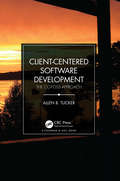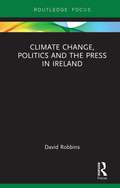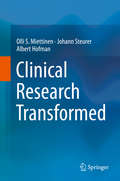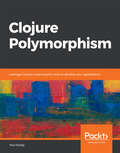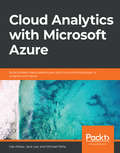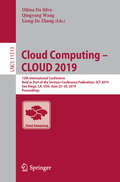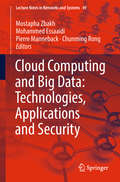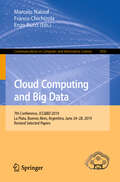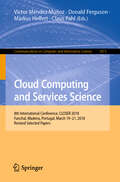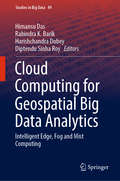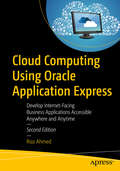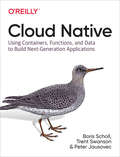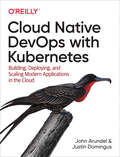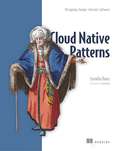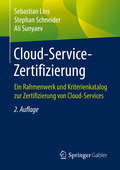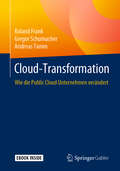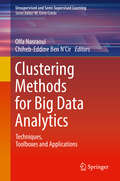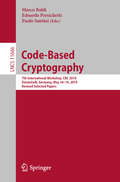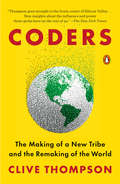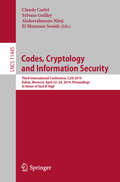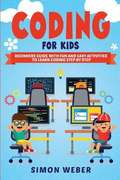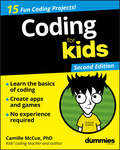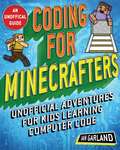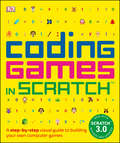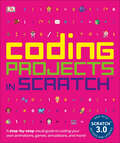- Table View
- List View
Client-Centered Software Development: The CO-FOSS Approach
by Allen B. TuckerClient-Centered Software Development: The CO-FOSS Approach introduces a method to creating a customized software product for a single client, either from scratch or by reusing open source components. The clients are typically non-profit humanitarian, educational, or public service organizations. This approach has been used in undergraduate courses where students learn the principles of software development while implementing a real-world software product. This book provides instructors, students, clients, and professional software developers with detailed guidance for developing a new CO-FOSS product from conceptualization to completion. Features Provides instructors, students, clients, and professional software developers with a roadmap for the development of a new CO-FOSS product from conceptualization to completion Motivates students with real-world projects and community service experiences Teaches all elements of the software process, including requirements gathering, design, collaboration, coding, testing, client communication, refactoring, and writing developer and user documentation Uses source code that can be reused and refitted to suit the needs of future projects, since each CO-FOSS product is free and open source software Provides links to a rich variety of resources for instructors and students to freely use in their own courses that develop new CO-FOSS products for other non-profits.
Climate Change, Politics and the Press in Ireland (Routledge Focus on Environment and Sustainability)
by David RobbinsMedia coverage of climate change has attracted much scholarly attention because the extent of such coverage has an agenda-setting effect and because the ways in which the coverage is framed can influence public perception of and engagement with the issue. However, certain gaps in our understanding of the processes whereby such coverage is produced remain. The competition among strategic actors to influence media framing strategies is poorly understood, and the perspectives of journalists and editors are largely absent from literature. With a view to advancing our understanding of the "frame competition" around climate change and to presenting the perspectives of journalists regarding climate change as a journalistic topic, this book presents an in-depth case history of media coverage of climate change in Ireland. First, the extent of media attention for climate change is established, and the way in which such coverage is framed is also examined. Through a series of interviews, including rare and privileged access to government ministers, their media advisors, and journalists and editors, the book uncovers the contest to establish a dominant framing. The main objective of this book is to advance our understanding of the contest to establish the dominant framing of climate change in the media discourse. Although focussed on Ireland, its conclusions are of value to those seeking to better understand the dynamics of media coverage of climate change in other contexts. This book will be of great interest to students and scholars of climate change, environmental policy, media and communication studies, and Irish politics.
Clinical Research Transformed
by Olli S. Miettinen Johann Steurer Albert HofmanIn this Information Age, the practices of clinical medicine should no longer be based on what clinical doctors actively know. Rather, all of the importantly practice-relevant knowledge should not only already exist but also be codified in cyberspace, in directly practice-guiding 'expert systems' -- for the benefit of both doctors and patients everywhere. Each of these systems (discipline-specific) would, prompted by a particular type of case presentation, present the doctor a questionnaire specific to cases of the type at issue, and document the doctor's answers to the questions. If at issue would be a case of complaint about a (particular type of) sickness, the system would translate the resulting diagnostic profile of the case into the corresponding probabilities of the illnesses to be considered. Similarly, if at issue would be an already-diagnosed case of a particular illness, the system would ask about, and record, the relevant elements in the prognostic profile of the case and then translate this profile into the probabilities of various outcomes to be considered, probabilities specific to the choice of treatment and prospective time in addition to that profile. And besides, these systems would analogously address the causal origin -- etiogenesis -- of cases of particular types of illness. While the requisite knowledge-base for these systems -- notably for the probabilities in them -- has not been addressed by such 'patient-oriented' clinical research as has been conducted (very extensively) up to now, this book delineates the nature of the suitably-transformed research (gnostic). The critically-transformative innovation in the research is the studies' focus on Gnostic Probability Functions -- dia-, etio-, and prognostic -- in the framework of logistic regression models. This book also presents a vision of how this critically-transformative research would most expeditiously be provided for and also conducted, among select sets of academic teaching hospitals.
Clojure Polymorphism: Leverage Clojure's polymorphic tools to develop your applications
by Paul StadigLearn when and how to use Clojure's polymorphic features to develop efficient multithreaded applications Key Features Get to grips with the different polymorphic tools that Clojure offers Develop a taste for good Clojure designs through various engaging examples Study various design principles and learn ways to use them in your applications Book Description Clojure is a modern, dynamic language that you can use to develop robust, multithreaded programs. Clojure Polymorphism is a comprehensive guide that shows you how to use Clojure's features to your advantage. The book begins by describing examples that show how to define and implement abstractions with plain functions and multimethods. Then you'll analyze these examples and separate the good and bad aspects of their design principles. You'll also learn how to perform data transformation abstraction with a plain function and discover how to write new cross-platform predicates while keeping the core of your abstraction free from reader conditionals. The later chapters explain the considerations to keep in mind when implementing Clojure protocols on the Java Virtual Machine (JVM). By the end of this book, you'll know how to use the various polymorphic tools of Clojure to your advantage while designing your applications. What you will learn Explore how polymorphism is implemented in Clojure Discover what design principles to use when creating and implementing abstractions Explore different ways to implement protocols in Clojure Implement various design principles while working with the JVM Write and compare plain functions and multimethods for transforming data Analyze functions and abstractions for their performance and flexibility Learn about common “gotchas” to avoid errors when writing code Who this book is for Clojure Polymorphism is useful for all programmers who want to leverage Clojure's polymorphic tools to build efficient applications. To get the most out of this book, you must be a moderately proficient Clojure programmer.
Cloud Analytics with Microsoft Azure: Build modern data warehouses with the combined power of analytics and Azure
by Has Altaiar Jack Lee Michael PenaLeverage the power of Azure to get efficient data insights from your big data in real time Key Features Explore the basics of cloud analytics using Azure Discover different ways to process and visualize your data easily Learn to use Azure Synapse Analytics (formerly known as Azure SQL Data Warehouse) to derive real-time customer insights Book Description With data being generated at an exponential speed, organizations all over the world are migrating their infrastructure to the cloud. Application management becomes much easier when you use a cloud platform to build, manage, and deploy your services and applications. Cloud Analytics with Microsoft Azure covers all that you need to extract useful insights from your data. You'll explore the power of data with big data analytics, the Internet of Things (IoT), machine learning, artificial intelligence, and DataOps. You'll also delve into data analytics by studying use cases that focus on creating actionable insights from near-real-time data. As you advance, you'll learn to build an end-to-end analytics pipeline on the cloud with machine learning and deep learning concepts. By the end of this book, you'll have developed a solid understanding of data analytics with Azure and its practical implementation. What you will learn Explore the concepts of modern data warehouses and data pipelines Discover different design considerations while applying a cloud analytics solution Design an end-to-end analytics pipeline on the cloud Differentiate between structured, semi-structured, and unstructured data Choose a cloud-based service for your data analytics solutions Use Azure services to ingest, store and analyze data of any scale Who this book is for If you're planning to adopt the cloud analytics model for your business, this book will help you understand the design and business considerations that you must keep in mind. Though not necessary, a basic understanding of data analytics concepts such as data streaming, data types, the machine learning life cycle, and Docker containers will help you get the most out of the book.
Cloud Computing – CLOUD 2019: 12th International Conference, Held as Part of the Services Conference Federation, SCF 2019, San Diego, CA, USA, June 25–30, 2019, Proceedings (Lecture Notes in Computer Science #11513)
by Qingyang Wang Liang-Jie Zhang Dilma Da SilvaThis volume constitutes the proceedings of the 12th International Conference on Cloud Computing, CLOUD 2019, held as part of the Services Conference Federation, SCF 2019, in San Diego, CA, USA, in June 2019. The 24 full papers were carefully reviewed and selected from 53 submissions. CLOUD has been a prime international forum for both researchers and industry practitioners to exchange the latest fundamental advances in the state of the art and practice of cloud computing, to identify emerging research topics, and to define the future of cloud computing. All topics regarding cloud computing align with the theme of CLOUD.
Cloud Computing and Big Data: Technologies, Applications and Security (Lecture Notes in Networks and Systems #49)
by Mostapha Zbakh Mohammed Essaaidi Pierre Manneback Chunming RongThis book addresses topics related to cloud and Big Data technologies, architecture and applications including distributed computing and data centers, cloud infrastructure and security, and end-user services. The majority of the book is devoted to the security aspects of cloud computing and Big Data. Cloud computing, which can be seen as any subscription-based or pay-per-use service that extends the Internet’s existing capabilities, has gained considerable attention from both academia and the IT industry as a new infrastructure requiring smaller investments in hardware platforms, staff training, or licensing software tools. It is a new paradigm that has ushered in a revolution in both data storage and computation. In parallel to this progress, Big Data technologies, which rely heavily on cloud computing platforms for both data storage and processing, have been developed and deployed at breathtaking speed. They are among the most frequently used technologies for developing applications and services in many fields, such as the web, health, and energy. Accordingly, cloud computing and Big Data technologies are two of the most central current and future research mainstreams. They involve and impact a host of fields, including business, scientific research, and public and private administration. Gathering extended versions of the best papers presented at the Third International Conference on Cloud Computing Technologies and Applications (CloudTech’17), this book offers a valuable resource for all Information System managers, researchers, students, developers, and policymakers involved in the technological and application aspects of cloud computing and Big Data.
Cloud Computing and Big Data: 7th Conference, JCC&BD 2019, La Plata, Buenos Aires, Argentina, June 24–28, 2019, Revised Selected Papers (Communications in Computer and Information Science #1050)
by Marcelo Naiouf Franco Chichizola Enzo RucciThis book constitutes the revised selected papers of the 7th International Conference on Cloud Computing and Big Data, JCC&BD 2019, held in La Plata, Buenos Aires, Argentina, in June 2019.The 12 full papers presented were carefully reviewed and selected from a total of 31 submissions. They are dealing with such topics as cloud computing and HPC; Big Data and data intelligence; mobile computing.
Cloud Computing and Services Science: 8th International Conference, CLOSER 2018, Funchal, Madeira, Portugal, March 19-21, 2018, Revised Selected Papers (Communications in Computer and Information Science #1073)
by Víctor Méndez Muñoz Donald Ferguson Markus Helfert Claus PahlThis book constitutes extended, revised and selected papers from the 8th International Conference on Cloud Computing and Services Science, CLOSER 2018, held in Funchal, Portugal in March 2018. The 11 papers presented in this volume were carefully reviewed and selected from a total of 94 submissions. CLOSER 2018 focused on the emerging area of Cloud Computing, inspired by some latest advances that concern the infrastructure, operations and available services throughout the global network.
Cloud Computing for Geospatial Big Data Analytics: Intelligent Edge, Fog And Mist Computing (Studies in Big Data #49)
by Himansu Das Rabindra K. Barik Harishchandra Dubey Diptendu Sinha RoyThis book introduces the latest research findings in cloud, edge, fog, and mist computing and their applications in various fields using geospatial data. It solves a number of problems of cloud computing and big data, such as scheduling, security issues using different techniques, which researchers from industry and academia have been attempting to solve in virtual environments. Some of these problems are of an intractable nature and so efficient technologies like fog, edge and mist computing play an important role in addressing these issues. By exploring emerging advances in cloud computing and big data analytics and their engineering applications, the book enables researchers to understand the mechanisms needed to implement cloud, edge, fog, and mist computing in their own endeavours, and motivates them to examine their own research findings and developments.
Cloud Computing Using Oracle Application Express: Develop Internet-Facing Business Applications Accessible Anywhere and Anytime
by Riaz AhmedGet the domain knowledge you need to develop real-world business apps for and in the cloud. You’ll see how Oracle APEX has made the life of web developers much easier and how it helps you create web-based data-centric applications easily and instantly without writing screeds of code.In Cloud Computing Using Oracle Application Express, you will develop a complete general ledger accounting system named the Cloud Accountant which will be accessible through a variety of devices including desktops, laptops, and the latest smartphones. This new edition also incorporates the new application page creation process, which differs from the previous version. You’ll cover other new areas, such as the updated UI elements and properties, and the interactive grid. Besides the development of a full application that you can deploy in your organization, the book teaches many new techniques to further enhance your APEX development skills.What You Will LearnDiscover new development techniques for APEX developersDevelop cloud-based ERP applicationsBuild a cloud-based application on Oracle APEXIntegrate the free JasperReports server and report designing tool with Oracle APEXWho This Book Is ForWeb developers who possess some working knowledge of Oracle Application Express, and developers who have been using Oracle Forms and now wish to use their existing SQL and PL/SQL expertise.
Cloud Native: Using Containers, Functions, and Data to Build Next-Generation Applications
by Peter Jausovec Boris Scholl Trent SwansonDevelopers often struggle when first encountering the cloud. Learning about distributed systems, becoming familiar with technologies such as containers and functions, and knowing how to put everything together can be daunting. With this practical guide, you’ll get up to speed on patterns for building cloud native applications and best practices for common tasks such as messaging, eventing, and DevOps.Authors Boris Scholl, Trent Swanson, and Peter Jausovec describe the architectural building blocks for a modern cloud native application. You’ll learn how to use microservices, containers, serverless computing, storage types, portability, and functions. You’ll also explore the fundamentals of cloud native applications, including how to design, develop, and operate them.Explore the technologies you need to design a cloud native applicationDistinguish between containers and functions, and learn when to use themArchitect applications for data-related requirementsLearn DevOps fundamentals and practices for developing, testing, and operating your applicationsUse tips, techniques, and best practices for building and managing cloud native applicationsUnderstand the costs and trade-offs necessary to make an application portable
Cloud Native DevOps with Kubernetes: Building, Deploying, and Scaling Modern Applications in the Cloud
by John Arundel Justin DomingusKubernetes is the operating system of the cloud-native world, providing a reliable and scalable platform for running containerized workloads. This book shows developers and operations staff how to apply industry-standard DevOps practices to Kubernetes in a cloud-native context. You’ll learn all about the Kubernetes ecosystem and discover battle-tested solutions to everyday problems.In this friendly, pragmatic book, cloud experts John Arundel and Justin Domingus show you what Kubernetes can do—and what you can do with it. You’ll build, step by step, an example cloud-native application and its supporting infrastructure, along with a development environment and continuous deployment pipeline that you can use for your own applications.Understand containers and Kubernetes from first principles—no experience necessaryRun your own clusters or choose a managed Kubernetes service from Amazon, Google, and othersDesign your own cloud-native services and infrastructureUse Kubernetes to manage resource usage and the container lifecycleOptimize clusters for cost, performance, resilience, capacity, and scalabilityLearn the best tools for developing, testing, and deploying your applicationsApply the latest industry practices for observability and monitoringSecure your containers and clusters in productionAdopt DevOps principles to help make your development teams lean, fast, and effective
Cloud Native Patterns: Designing change-tolerant software
by Cornelia DavisSummaryCloud Native Patternsis your guide to developing strong applications that thrive in the dynamic, distributed, virtual world of the cloud. This book presents a mental model for cloud-native applications, along with the patterns, practices, and tooling that set them apart.Purchase of the print book includes a free eBook in PDF, Kindle, and ePub formats from Manning Publications.About the TechnologyCloud platforms promise the holy grail: near-zero downtime, infinite scalability, short feedback cycles, fault-tolerance, and cost control. But how do you get there? By applying cloudnative designs, developers can build resilient, easily adaptable, web-scale distributed applications that handle massive user traffic and data loads. Learn these fundamental patterns and practices, and you'll be ready to thrive in the dynamic, distributed, virtual world of the cloud.About the BookWith 25 years of experience under her belt, Cornelia Davis teaches you the practices and patterns that set cloud-native applications apart. With realistic examples and expert advice for working with apps, data, services, routing, and more, she shows you how to design and build software that functions beautifully on modern cloud platforms. As you read, you will start to appreciate that cloud-native computing is more about the how and why rather than the where. What's insideThe lifecycle of cloud-native appsCloud-scale configuration managementZero downtime upgrades, versioned services, and parallel deploysService discovery and dynamic routingManaging interactions between services, including retries and circuit breakersAbout the ReaderRequires basic software design skills and an ability to read Java or a similar language.About the AuthorCornelia Davis is Vice President of Technology at Pivotal Software. A teacher at heart, she's spent the last 25 years making good software and great software developers.Table of ContentsPART 1 - THE CLOUD-NATIVE CONTEXTYou keep using that word: Defining "cloud-native"Running cloud-native applications in productionThe platform for cloud-native softwarePART 2 - CLOUD-NATIVE PATTERNSEvent-driven microservices: It's not just request/responseApp redundancy: Scale-out and statelessnessApplication configuration: Not just environment variablesThe application lifecycle: Accounting for constant changeAccessing apps: Services, routing, and service discoveryInteraction redundancy: Retries and other control loopsFronting services: Circuit breakers and API gatewaysTroubleshooting: Finding the needle in the haystackCloud-native data: Breaking the data monolith
Cloud-Service-Zertifizierung: Ein Rahmenwerk und Kriterienkatalog zur Zertifizierung von Cloud-Services
by Sebastian Lins Stephan Schneider Ali SunyaevDieses Buch liefert ein Rahmenwerk zur Zertifizierung von Services in der Cloud. Herzstück dabei ist ein umfangreicher Kriterienkatalog zum Assessment von Cloud-Services, der im Forschungsprojekt „Value4Cloud“ , gefördert vom Bundesministerium für Wirtschaft und Technologie, entwickelt wurde. Cloud-Service-Anwender werden bei der Bewertung, dem Vergleich und der Auswahl von Services unterstützt. Das Buch eignet sich auch für Cloud-Service-Anbieter zum Self-Assessment und zur Verbesserung der eigenen Services.
Cloud-Transformation: Wie die Public Cloud Unternehmen verändert
by Roland Frank Gregor Schumacher Andreas TammIn diesem Buch lernen Sie, wie die Public Cloud die Kostenstrukturen von digitalen Geschäftsmodellen und damit bestehende Märkte signifikant verändert. Die Zusammenhänge zwischen den verwendeten Cloud-Architekturen, der Organisation des Unternehmens und den dadurch möglichen Preis- und Geschäftsmodellen werden übersichtlich und für den Einsatz im eigenen Unternehmen nutzbar aufbereitet.Die Autoren erläutern, wie der Reihe nach immer mehr Märkte zu digitalen Märkten werden und welche Rolle die Grenzkosten dabei spielen. Sie beschreiben, wie die cloudbasierte IT die klassische IT disruptiert. Dadurch können kleine Teams mit geringen Investitionen weltweit skalierende Geschäftsmodelle zu Null-Grenzkosten aufbauen. Die wirtschaftlichen Effekte werden anhand konkreter Beispiele nachvollziehbar dargestellt. Zusätzlich erhalten technische Laien einen Überblick, welche Faktoren für die Wettbewerbsfähigkeit ihrer digitalen Geschäftsmodelle besonders wichtig sind und wie Manager diese beeinflussen können. Zum Abschluss gibt das Buch Praktikern einen konkreten Leitfaden an die Hand, wie die Cloud-Transformation im Unternehmen durchgeführt werden kann. Das Buch richtet sich vor allem an Führungskräfte und Mitarbeiter in den Fachbereichen und der IT, die die Cloud-Transformation in ihren Unternehmen vorantreiben möchten.
Clustering Methods for Big Data Analytics: Techniques, Toolboxes and Applications (Unsupervised and Semi-Supervised Learning)
by Olfa Nasraoui Chiheb-Eddine Ben N'CirThis book highlights the state of the art and recent advances in Big Data clustering methods and their innovative applications in contemporary AI-driven systems. The book chapters discuss Deep Learning for Clustering, Blockchain data clustering, Cybersecurity applications such as insider threat detection, scalable distributed clustering methods for massive volumes of data; clustering Big Data Streams such as streams generated by the confluence of Internet of Things, digital and mobile health, human-robot interaction, and social networks; Spark-based Big Data clustering using Particle Swarm Optimization; and Tensor-based clustering for Web graphs, sensor streams, and social networks. The chapters in the book include a balanced coverage of big data clustering theory, methods, tools, frameworks, applications, representation, visualization, and clustering validation.
Code-Based Cryptography: 7th International Workshop, CBC 2019, Darmstadt, Germany, May 18–19, 2019, Revised Selected Papers (Lecture Notes in Computer Science #11666)
by Marco Baldi Edoardo Persichetti Paolo SantiniThis book constitutes the refereed and revised post-conference proceedings of the 7th International Workshop on Code-Based Cryptography, CBC 2019, held in Darmstadt, Germany, in May 2019. The eight papers presented in this book were carefully reviewed and selected from numerous submissions. These contributions are divided into two groups: The first four papers deal with the design of code-based cryptosystems, while the following four papers are on cryptanalysis of code-based cryptosystems.
Coders: The Making of a New Tribe and the Remaking of the World
by Clive ThompsonHello, world.Facebook's algorithms shaping the news. Self-driving cars roaming the streets. Revolution on Twitter and romance on Tinder. We live in a world constructed of code--and coders are the ones who built it for us. From acclaimed tech writer Clive Thompson comes a brilliant anthropological reckoning with the most powerful tribe in the world today, computer programmers, in a book that interrogates who they are, how they think, what qualifies as greatness in their world, and what should give us pause. They are the most quietly influential people on the planet, and Coders shines a light on their culture.In pop culture and media, the people who create the code that rules our world are regularly portrayed in hackneyed, simplified terms, as ciphers in hoodies. Thompson goes far deeper, dramatizing the psychology of the invisible architects of the culture, exploring their passions and their values, as well as their messy history. In nuanced portraits, Coders takes us close to some of the great programmers of our time, including the creators of Facebook's News Feed, Instagram, Google's cutting-edge AI, and more. Speaking to everyone from revered "10X" elites to neophytes, back-end engineers and front-end designers, Thompson explores the distinctive psychology of this vocation--which combines a love of logic, an obsession with efficiency, the joy of puzzle-solving, and a superhuman tolerance for mind-bending frustration. Along the way, Coders thoughtfully ponders the morality and politics of code, including its implications for civic life and the economy. Programmers shape our everyday behavior: When they make something easy to do, we do more of it. When they make it hard or impossible, we do less of it. Thompson wrestles with the major controversies of our era, from the "disruption" fetish of Silicon Valley to the struggle for inclusion by marginalized groups.In his accessible, erudite style, Thompson unpacks the surprising history of the field, beginning with the first coders -- brilliant and pioneering women, who, despite crafting some of the earliest personal computers and programming languages, were later written out of history. Coders introduces modern crypto-hackers fighting for your privacy, AI engineers building eerie new forms of machine cognition, teenage girls losing sleep at 24/7 hackathons, and unemployed Kentucky coal-miners learning a new career. At the same time, the book deftly illustrates how programming has become a marvelous new art form--a source of delight and creativity, not merely danger. To get as close to his subject as possible, Thompson picks up the thread of his own long-abandoned coding skills as he reckons, in his signature, highly personal style, with what superb programming looks like. To understand the world today, we need to understand code and its consequences. With Coders, Thompson gives a definitive look into the heart of the machine.
Codes, Cryptology and Information Security: Third International Conference, C2SI 2019, Rabat, Morocco, April 22–24, 2019, Proceedings - In Honor of Said El Hajji (Lecture Notes in Computer Science #11445)
by Claude Carlet Sylvain Guilley Abderrahmane Nitaj El Mamoun SouidiThis book constitutes the proceedings of the Third International Conference on Codes, Cryptology and Information Security, C2SI 2019, held in Rabat, Morocco, in April 2019. The 19 regular papers presented together with 5 invited talks were carefully reviewed and selected from 90 submissions. The first aim of this conference is to pay homage to Said El Hajji for his valuable contribution in research, teaching and disseminating knowledge in numerical analysis, modeling and information security in Morocco, Africa, and worldwide. The second aim of the conference is to provide an international forum for researchers from academia and practitioners from industry from all over the world for discussion of all forms of cryptology, coding theory, and information security.
Coding for Kids: Beginners Guide With Fun And Easy Activities To Learn Coding Step By Step
by Simon WeberThis book is intended for children who wish to learn programming and computing. In this day and age, computer knowledge, or literacy, if we may call it that, is of huge importance for every person, from early childhood on through to his or her adult, professional lives. Even in the preschool system, children very often have tasks given to them by their teachers, which require the use of computers to a certain extent. That is precisely the reason this book would be of good use both for teachers and for children. Teachers will get help on the topic of how to bring the computer closer to children, and children get the opportunity to learn their first basic knowledge of computers and their use. They also get their first clues on the benefits computers can bring to them and their lives.
Coding For Kids For Dummies (For Kids For Dummies)
by Camille McCue Ph.DA guide for kids who want to learn coding Coding is quickly becoming an essential academic skill, right up there with reading, writing, and arithmetic. This book is an ideal way for young learners ages 8-13 who want more coding knowledge than you can learn in an hour, a day, or a week. Written by a classroom instructor with over a decade of experience teaching technology skills to kids as young as five, this book teaches the steps and logic needed to write code, solve problems, and create fun games and animations using projects based in Scratch and JavaScript. This 2nd Edition is fully updated to no longer require any limited-time software downloads to complete the projects. Learn the unique logic behind writing computer code Use simple coding tools ideal for teaching kids and beginners Build games and animations you can show off to friends Add motion and interactivity to your projects Whether you’re a kid ready to make fun things using technology or a parent, teacher, or mentor looking to introduce coding in an eager child’s life, this fun book makes getting started with coding fun and easy!
Coding for Minecrafters: Unofficial Adventures for Kids Learning Computer Code
by Ian GarlandLearn to Code while Adventuring through the Overworld!This fun and educational activity book Introduces kids to the world of coding through the Minecraft world they love. Colorfully illustrated characters and themes from their favorite video game bring the excitement of coding to life, while easy-to-follow screenshots guide them through activities. With adventures that include design, music, animation, gaming, and more, learners will discover tons of ways coding connects to other activities they love and how far a little imagination and invention can take them…to The End and beyond! Minecrafting-themed characters help kids become master coders Kid-friendly concepts and steps designed specifically for ages 8-12 Great games, mods, experiments, and more teach computational thinking—how to tackle large problems by breaking them down into a sequence of smaller, more manageable problems Whether brand-new to coding or looking for more hands-on learning, Coding for Minecrafters helps young coders advance in technology education by leaps and bounds—and have fun doing it!
Coding Games in Scratch: A Step-by-Step Visual Guide to Building Your Own Computer Games (DK Help Your Kids)
by Jon WoodcockScratch 3.0 has landed! Stay ahead of the curve with this fully updated guide for beginner coders.Coding is not only a highly sought-after skill in our digital world, but it also teaches kids valuable skills for life after school. This book teaches important strategies for solving problems, designing projects, and communicating ideas, all while creating games to play with their friends.Children will enjoy the step-by-step visual approach that makes even the most difficult coding concepts easy to master. They will discover the fundamentals of computer programming and learn to code through a blend of coding theory and the practical task of building computer games themselves. The reason coding theory is taught through practical tasks is so that young programmers don't just learn how computer code works - they learn why it's done that way. With Coding Games in Scratch, kids can build single and multiplayer platform games, create puzzles and memory games, race through mazes, add animation, and more. It also supports STEM education initiatives and the maker movement.Follow Simple Steps – Improve Your Skills – Share Your Games!If you like playing computer games, why not create your own? Essential coding concepts are explained using eight build-along game projects. Coding Games In Scratch guides young coders step-by-step, using visual samples, easy-to-follow instructions, and fun pixel art. This coding book for kids has everything you need to build amazing Scratch 3.0 games, including thrilling racing challenges, zany platform games, and fiendish puzzles. Follow the simple steps to become an expert coder using the latest version of the popular programming language Scratch 3.0 in this new edition. Improve your coding skills and create your own games before remixing and customizing them. Share your games online and challenge friends and family to beat each other's scores! In this book, you will: - Learn about setting the scene, what makes a good game and playability- Discover objects, rules, and goals- Explore hacks and tweaks, camera angles, fine-tuning and controls- And much moreComputer coding teaches kids how to think creatively, work collaboratively, and reason systematically, and is quickly becoming a necessary and sought-after skill. DK's computer coding books for kids are full of fun exercises with step-by-step guidance, making them the perfect introductory tools for building vital skills in computer programming. Add Coding Projects in Scratch and Coding Projects in Python to your collection.
Coding Projects in Scratch: A Step-by-Step Visual Guide to Coding Your Own Animations, Games, Simulations, a (DK Help Your Kids)
by Jon WoodcockA perfect introduction to coding for young minds! This updated step-by-step visual guide teaches children to create their own projects using Scratch 3.0.Suitable for complete beginners, this educational book for kids gives readers a solid understanding of programming. Teach them to create their own projects from scratch, preparing them for more complex programming languages like Python.Techy kids will familiarize themselves with Scratch 3.0 using this beginner's guide to scratch coding. Difficult coding concepts become fun and easy to understand, as budding programmers build their own projects using the latest release of the world's most popular programming language for beginners.Make a Dino Dance Party or create your own electronic birthday cards for friends and family. Build games, simulations, and mind-bending graphics as you discover the awesome things computer programmers can do with Scratch 3.0. This second edition of Coding Projects in Scratch uses a visual step-by-step approach to split complicated code into manageable, easy-to-digest chunks. Even the most impressive projects become possible. This book is an impressive guide that is perfect for anyone who wants to learn to code. Follow Simple Steps, Improve Your Skills & Share Your Creations!Follow the simple steps to become an expert coder using the latest version of the popular programming language Scratch 3.0 in this new edition. Create mind-bending illusions, crazy animations, and interactive artwork with this amazing collection of Scratch projects. Suitable for beginners and experts alike, this fabulous introduction to programming for kids has everything you need to learn how to code. You'll improve your coding skills and learn to create and customize your own projects, then you can share your games online and challenge friends and family to beat each other's scores! What's inside this kids' coding book? - Simulations, mind-benders, music, and sounds- Algorithms, virtual snow, and interactive features- Different devices, operating systems, programming languages and moreComputer coding teaches kids how to think creatively, work collaboratively, and reason systematically, and is quickly becoming a necessary and sought-after skill. DK's computer coding books for kids are full of fun exercises with step-by-step guidance, making them the perfect introductory tools for building vital skills in computer programming. Coding Projects in Scratch is one of three brilliant coding books for kids. Add Coding Games in Scratch and Coding Projects in Python to your collection.
